- AustraliaNorth AmericaWorld
Investing News NetworkYour trusted source for investing success
- Lithium Outlook
- Oil and Gas Outlook
- Gold Outlook Report
- Uranium Outlook
- Rare Earths Outlook
- All Outlook Reports
- Top Generative AI Stocks
- Top EV Stocks
- Biggest AI Companies
- Biggest Blockchain Stocks
- Biggest Cryptocurrency-mining Stocks
- Biggest Cybersecurity Companies
- Biggest Robotics Companies
- Biggest Social Media Companies
- Biggest Technology ETFs
- Artificial Intellgience ETFs
- Robotics ETFs
- Canadian Cryptocurrency ETFs
- Artificial Intelligence Outlook
- EV Outlook
- Cleantech Outlook
- Crypto Outlook
- Tech Outlook
- All Market Outlook Reports
- Cannabis Weekly Round-Up
- Top Alzheimer's Treatment Stocks
- Top Biotech Stocks
- Top Plant-based Food Stocks
- Biggest Cannabis Stocks
- Biggest Pharma Stocks
- Longevity Stocks to Watch
- Psychedelics Stocks to Watch
- Top Cobalt Stocks
- Small Biotech ETFs to Watch
- Top Life Science ETFs
- Biggest Pharmaceutical ETFs
- Life Science Outlook
- Biotech Outlook
- Cannabis Outlook
- Pharma Outlook
- Psychedelics Outlook
- All Market Outlook Reports
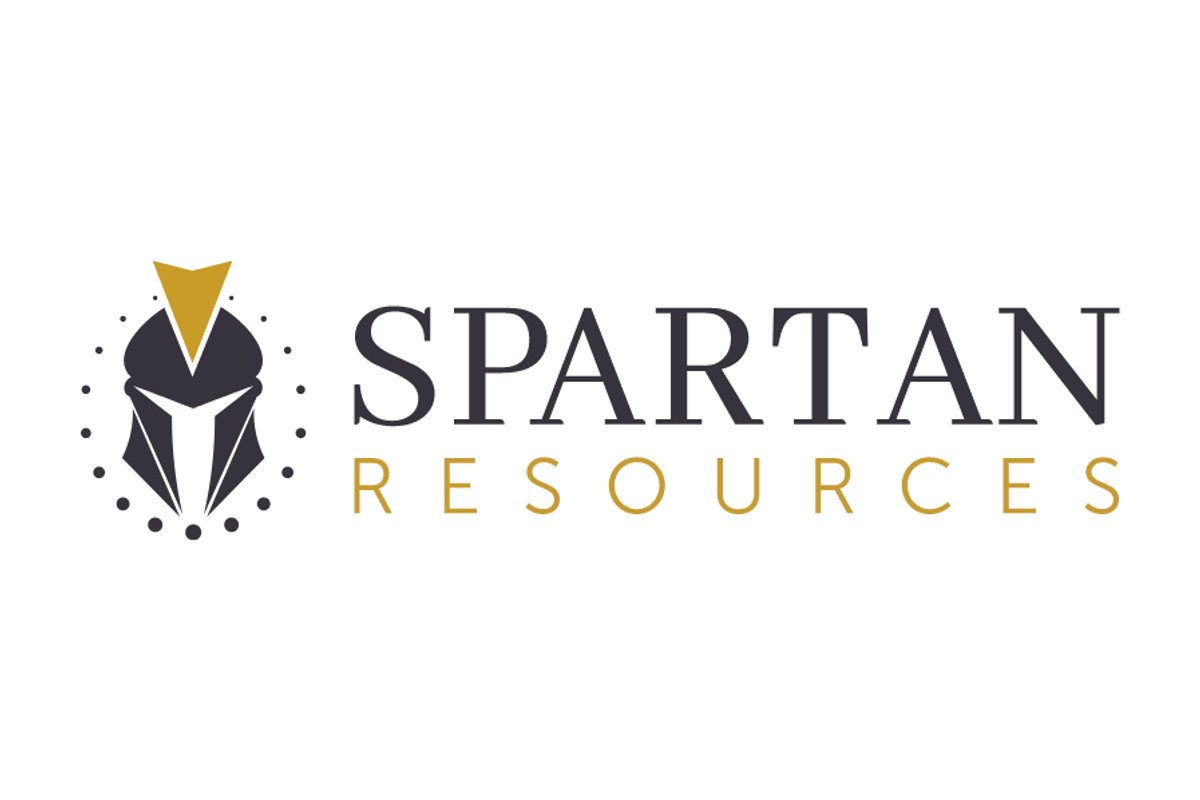
Spartan Announces Updated Exploration Target for the Never Never Gold Deposit
Spartan targets further significant growth in high-grade resources and value in 2024, supported by recent successful extensional drilling
Spartan Resources Limited (ASX: SPR) (Spartan or the Company) is pleased to advise that it has calculated a new JORC-compliant Exploration Target for the high-grade Never Never Gold Deposit, part of its Dalgaranga Gold Project in Western Australia.
Highlights:
- New JORC-compliant “Exploration Target” completed for the Never Never Gold Deposit, part of Spartan’s flagship 1.69Moz @ 2.49g/t gold Dalgaranga Gold Project (100%-owned), located in the Murchison Region of Western Australia.
- The new Never Never Exploration Target set out here is inclusive of the recent Never Never Mineral Resource Estimate (“MRE”), updated in December 2023 to:
- 5.16Mt at 5.74g/t Au for 952,900oz gold
- Spartan remains focused on delivering increased shareholder value through high-impact exploration and high-grade resource growth, with:
- Never Never being one of the highest-grade and fastest growing new gold discoveries in Western Australia;
- Never Never sitting immediately adjacent to a 100% owned, well maintained, 6-year- old 2.5Mtpa CIL gold processing plant and associated infrastructure;
- Plus, a technically strong and focused management team with a proven track- record of rapidly growing asset value, rejuvenating existing mines, extending mine lives through exploration success and delivering on targets.
- An extensive 28,500m drilling program is currently underway, with four diamond rigs and one Reverse Circulation rig currently on site.
Exploration Target
The new Exploration Target comprises:
The potential quantity and grade of the Exploration Target is conceptual in nature and, as such, there has been insufficient exploration drilling conducted to estimate a Mineral Resource. At this stage it is uncertain if further exploration drilling will result in the estimation of a Mineral Resource. The Exploration Target has been prepared in accordance with the JORC Code (2012).
Note: The Exploration target is inclusive of the December 2023 Mineral Resource Estimate released for the Never Never Gold Deposit of 5.16Mt at 5.74g/t Au for 0.95Moz gold1
Exploration Target Basis
During 2023, Spartan drilled 232 holes for 63,943m at Dalgaranga, with 111 holes (48%) for 38,328m (60%) completed at Never Never, growing the MRE from 303.1koz to 952.9koz (214%). To date, Spartan has spent A$14.7M on drilling at Never Never, resulting in a very low discovery cost of A$15.43 per resource ounce.
Click here for the full ASX Release
This article includes content from Spartan Resources Limited, licensed for the purpose of publishing on Investing News Australia. This article does not constitute financial product advice. It is your responsibility to perform proper due diligence before acting upon any information provided here. Please refer to our full disclaimer here.
Omar Ayales: Gold, Silver, Juniors Have Explosive Upside — Not Being in Trade is Top Risk
Speaking to the Investing News Network, Omar Ayales of Gold Charts R Us discussed the outlook for gold from a technical perspective, saying that he sees the metal's price potentially peaking in 2026.
Gold's past performance indicates that it could reach US$4,000 per ounce during this cycle. He sees US$2,600 as a bullish support level for gold, with deeper support existing in the US$2,200 to US$2,300 range.
However, Ayales said there's no guarantee that the yellow metal will fall that low at this point.
"I think that we're going to see higher highs — I think the risk of not being in the move as it reaches a high is a lot more than the risk to the downside that you could experience at this moment," he explained.
Watch the interview above for more of Ayales' thoughts on what's ahead for gold, as well as silver. You can also click here to view the Investing News Network's New Orleans Investment Conference playlist on YouTube.
Don't forget to follow us @INN_Resource for real-time updates!
Securities Disclosure: I, Charlotte McLeod, hold no direct investment interest in any company mentioned in this article.
Editorial Disclosure: The Investing News Network does not guarantee the accuracy or thoroughness of the information reported in the interviews it conducts. The opinions expressed in these interviews do not reflect the opinions of the Investing News Network and do not constitute investment advice. All readers are encouraged to perform their own due diligence.
Newmont to Sell Cripple Creek & Victor Mine Amid Firm-wide Restructuring
Newmont (TSX:NGT,NYSE:NEM) announced the sale of its Cripple Creek & Victor mine in Colorado, US, to SSR Mining (TSX:SSRM,NASDAQ:SSRM) for up to US$275 million, continuing its ongoing restructuring efforts.
Under the terms of the deal, Newmont will receive US$100 million in cash upon closing, with an additional US$175 million contingent on regulatory approvals and conditions related to the Carlton Tunnel.
Newmont has agreed to bear 90 percent of potential closure costs exceeding US$500 million under a future regulator-approved closure plan. The transaction is expected to close in the first quarter of 2025.
For the better part of the year, Newmont has prioritized divesting its non-core assets to focus on its Tier 1 gold and copper operations. It is aiming to achieve up to US$3.9 billion in proceeds through asset sales and other liquidations.
Recent sales include the Telfer operation and a majority stake in the Havieron project for up to $475 million, alongside divestitures of the Akyem, Musselwhite and Éléonore operations. The company has also raised US$527 million through sales of other investments, including its Lundin Gold (TSX:LUG,OTCQX:LUGDF) stream credit facility.
In tandem with these divestitures, Newmont is implementing widespread organizational changes, including layoffs and a consolidation of its global business units. The company recently announced the dismissal of several senior managers, including an executive, as part of efforts to align its operational structure with its strategic priorities.
In addition, five standalone business units are being merged into three, eliminating divisions overseeing operations in Australia and Africa and integrating them with those managing North America and East Asia.
These changes come after Newmont’s acquisition of Newcrest Mining in 2023, which added significant gold and copper assets to its portfolio. The restructuring aims to reduce redundancy and optimize the organization for long-term success.
The overhaul also responds to challenges highlighted in Newmont’s third quarter report, which reveals rising costs at the company's mines in Australia, Canada and Peru.
Despite a 30 percent increase in the gold price this year, Newmont’s share price performance has been modest, prompting internal reviews and discussions with investors about the company’s current approach.
Don't forget to follow us @INN_Resource for real-time news updates!
Securities Disclosure: I, Giann Liguid, hold no direct investment interest in any company mentioned in this article.
Black Swans, White Swans and Trump’s Clash with the Fed
The Trump administration’s ability to reign in government spending, quash inflation and bolster the economy were the most prevalent topics during the popular economy panel at the New Orleans Investment Conference.
Moderated by Adrian Day, president Adrian Day Asset Management, this year’s discussion featured James Lavish, Jim Bianco, Dr. Mark Skousen, Brent Johnson and James Grant. The expert group began the discussion by debating the potential economic impact Donald Trump could have, highlighting contradictions in his policies.
Johnson, who is CEO of Santiago Capital, pointed out that Trump's anti-inflation stance conflicts with his push for a weak US dollar and tariffs, which Johnson likened to global rate hikes.
“I would say that Trump's policies in many ways contradict each other in some way,” he said.
“Sometimes he will say, 'I want to kill inflation,' but then he will also say he wants a weak dollar. And then the next sentence, he will say, 'The greatest word in the world is tariffs,'" Johnson explained.
“The reality is, even if he gets his rate cuts, tariffs are basically like a rate hike for the rest of the world, because it's going to mean less dollars circulating outside the US. And that has tremendous implications for the global economy.”
Skousen, an economist and author, countered Johnson’s stance, asserting that Trump favors a strong dollar.
“Trump is known for 'king dollar.' He wants a strong dollar. I don't know where he got the weak dollar business,” he said. “Make America Great Again is all about making the dollar strong.”
Skousen then took aim at Trump’s proposed 20 percent tariff on imports, saying it isn't likely pass in Congress.
“Economists across the board have done study after study showing that tariffs are bad long term and short term for the country. Donald Trump was asleep when he took econ at the Wharton School, because he should know better than to push that agenda,” he said.
DOGE Commission and Trump tariff talk
Next up, Grant, a financial journalist and historian, pointed to the redundancy in Trump’s appointments for the Department of Government Efficiency, also referred to as the DOGE Commission.
“If you want to bury an idea in Washington, form a commission,” Grant quipped. “The DOGE Commission, the directive on government efficiency, ladies and gentlemen, has two CEOs.”
He added, “To bring down government spending and to reduce the growth in public debt, President-elect Trump would not have said he would never touch entitlements — but he said that."
Ultimately Grant believes “the rhetoric is stronger than the intention.”
The panelists also explored potential friction between Trump and the Federal Reserve, speculating on whether Trump will clash with or attempt to dismiss Chair Jerome Powell.
“Let's talk about the president-elect, Donald Trump, and who is perceived to be the second most powerful person in Washington — that is the Federal Reserve chairman,” said Bianco, president and macro strategist at Bianco Research.
“Trump is not going to reappoint Powell, but Powell knew that he wasn’t going to get reappointed; even if Harris won, she was probably going to appoint (Lael) Brainard to replace him in May of '26," he went on to note.
While Trump is unlikely to reappoint Powell at the end of his term as Fed chair, Bianco does believe Trump is going to make it challenging for Powell to operate.
"Trump is not, I don't think, going to fire Powell. I don't think he wants to have the spectacle,” he said. “He'll just threaten to fire him every week, and blame everything, including male pattern baldness, on Powell.”
After the laughter from the audience dissipated, Bianco warned that Trump has previously said he would like to be both POTUS and Fed chair — something that has never been done in the country's history.
Trump’s relationship with the Fed is likely to start on bumpy terms as Powell works to reduce inflation.
“The Fed might be done cutting rates, and Trump wouldn't be wrong to say, 'Boy, did that look very political. You were cutting rates before the election like crazy, 50 basis points. Then I (get elected) and you stop?' That could wind up becoming a narrative early in the Trump administration, his stressed relationship with the Fed chairman."
Although Trump would like to wield more power over the Fed, during a November 8 press conference, Powell told reporters he won't resign if Trump asks, nor does the president-elect have the power to fire him.
Lavish, managing partner at the Bitcoin Opportunity Fund, also pointed to Trump’s double speak as a serious problem, heading into the next four years. “Trump speaks in contradictions,” he told the audience, explaining that while Trump talks tough on tariffs, they may be more rhetorical than actionable.
He also noted that Trump’s "drill, baby, drill" stance aims to reduce US energy costs, which would lower inflation — yet his push for a booming stock market and strong economy could fuel inflation instead.
Trump’s pressure on the Fed to maintain easy monetary policy reflects his desire for market highs, despite criticizing Powell. Cutting federal spending significantly seems unlikely, as trimming entitlements or laying off workers would barely dent the budget. Ultimately, Trump's policies may favor liquidity, potentially keeping inflation elevated.
Black swans vs. white swans
At the end of the discussion Day, gave each panelist 45 seconds to describe what they believe are the potential economic black and white swan events on the horizon.
Skousen said it could be positive or negative if Trump imitates Argentinian President Javier Milei’s economic policies.
“(Milei) is doing a lot of really good things with really trying to reduce government and reduce the national debt, which is a problem and is headed for a crisis," he said.
Trump and Milei share a populist, anti-establishment outlook, but their economic policies reflect different approaches. Trump's strategy emphasizes protectionism, tariffs and "America First" nationalism, contrasting with Milei's free-market libertarianism, which includes proposals like dollarizing Argentina's economy and drastically reducing state involvement.
Building on Skousen's stance, Johnson stressed the importance of Trump being steadfast.
“I think the potential white swan is that most of the success that is attributed to Milei in Argentina is because he has hit the ground running. He hasn't slowed down," he commented.
"He's done exactly what he said he would do, and he keeps charging 100 miles an hour. If Trump does something similar, he has a better chance than is currently expected. But if he slows down, then they'll eat him alive."
Bianco underscored that the economy is currently at its full potential, driven by fiscal stimulus.
He then cautioned that if the Fed continues to cut interest rates, it could push long-term yields even higher instead of curbing inflation. This might trigger a sudden bond market collapse, reminiscent of the 2019 repo market spike.
“If the Fed wants to continue to cut rates, they're just going to continue to drive long-term yields higher and higher and higher, because they're not fighting inflation,” said Bianco.
“And that could very well turn into a black swan event. A white swan event would be the opposite.”
Lavish also warned of potential trouble in the bond market.
“(If) we have some sort of event like you saw in the fall of 2019, where you saw the repo market spike up, whether that happens because of policy error by the Fed or for some other reason, that's a black swan event,” he said. “The white swan event would be — I don't know how this would ever happen — but these guys balance the budget.”
For Grant, the black swan would be inflation rising while the Fed cuts rates due to "dysfunction in the government bond market." That would "crystallize fiscal error and underlying inflation, and the Fed's too-big balance sheet.”
On the other hand, he joked, Powell buying “his first ounce of gold” would be a white swan event.
Keep an eye out for the rest of INN’s coverage from the New Orleans Investment Conference, including exclusive video interviews and full panel overviews.
Don't forget to follow us @INN_Resource for real-time updates!
Securities Disclosure: I, Georgia Williams, hold no direct investment interest in any company mentioned in this article.
Gold Price 2024 Year-End Review
Gold saw incredible price gains in 2024, rising from US$2,000 per ounce to close to US$2,800.
Various factors have lent support, including 75 basis points worth of interest rate cuts from the US Federal Reserve, geopolitical instability in Eastern Europe and the Middle East and uncertainty in global financial markets.
Of course, it wasn't all an upward climb for gold — following the US presidential election, Donald Trump emerged victorious, and the gold price experienced volatility as investors flocked to Bitcoin.
Read on for more on what factors moved the gold price in Q4, followed by a look back at the entire year.
Gold price in Q4
The gold price began Q4 at US$2,660.30, but quickly saw a retraction to US$2,608.40 on October 9. However, the decline didn't last, and gold again rose, setting a new record high of US$2,785.40 on October 30.
The surge upward was fueled by a weaker-than-expected September US consumer price index report, which showed annual inflation of 2.4 percent and monthly inflation of 0.2 percent. These numbers were higher than analysts' forecasts of 2.3 and 0.1 percent, raising expectations that the Fed would cut rates at its November meeting.
Gold was in retreat to start November, dropping to US$2,664 on November 6 after Trump’s victory. The next day, it briefly surged above the US$2,700 mark as the Fed cut interest rates by 25 basis points on November 7.
By November 15, the price of gold had fallen to its quarterly low of US$2,562.50.
The end of the month saw gold leap to US$2,715.80 on November 22. Following this peak, gold entered December below the US$2,700 mark, closing at US$2,660.50 on December 9.
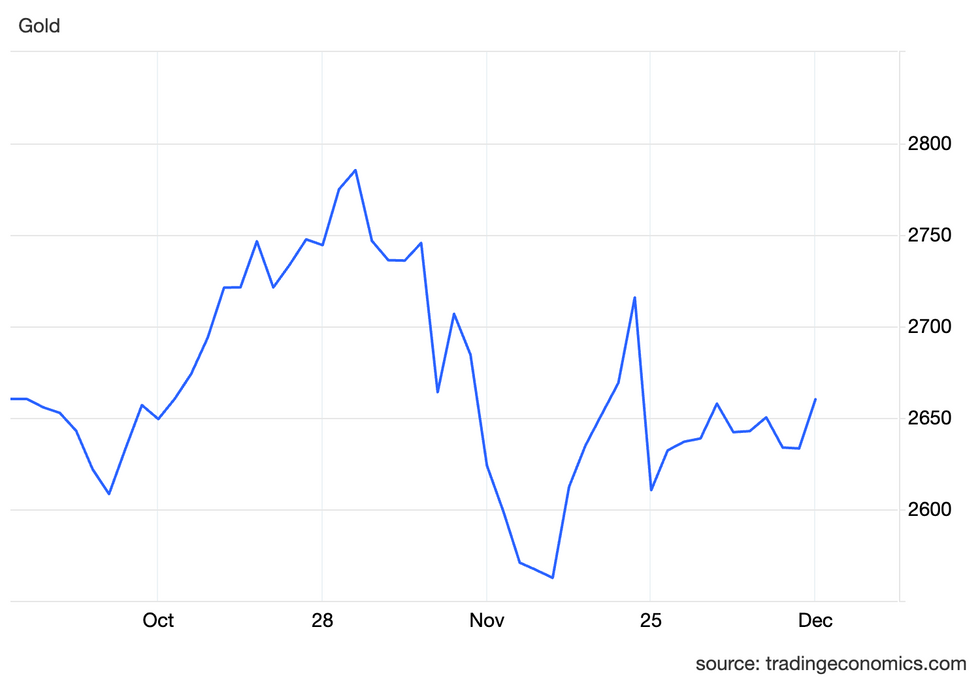
Gold price, Q4 2024.
Chart via Trading Economics.
Geopolitical impacts have been important to gold in Q4.
In addition to Trump's re-election, which has caused turmoil in various forms, on November 17 the US authorized Ukraine to use ATACMS long-range missiles to attack targets deeper into Russian territory. The UK and France mirrored this move, giving Ukraine the green light to use long-range missiles in the ongoing conflict.
Tensions continued to ratchet up in the days following as Russia announced it was lowering the threshold for nuclear retaliation to include conventional attacks from countries backed by nuclear nations. In a demonstration of its capabilities, Russia launched an intermediate-range ballistic missile for the first time on November 21. While the missile appeared only to carry inert warheads, it is capable of delivering both conventional and nuclear armaments.
The threat of a significant escalation has bolstered gold’s appeal as a safe-haven asset and store of value.
How did gold perform for the rest of the year?
Gold price in Q1
Gold set its first record price of the year at US$2,251.37 on March 31.
Central bank buying, notably China's purchase of 22 metric tons of gold in the first two months of the year, supported the price. Turkey, Kazakhstan and India also significantly increased their holdings at the start of the year.
Further momentum came from Chinese wholesale demand, which jumped to 271 metric tons in January, the strongest ever recorded. Investors were turning to the yellow metal as a defense against falling real estate and stock prices. At that time, the country's stocks had lost nearly US$5 trillion in value over the past three years.
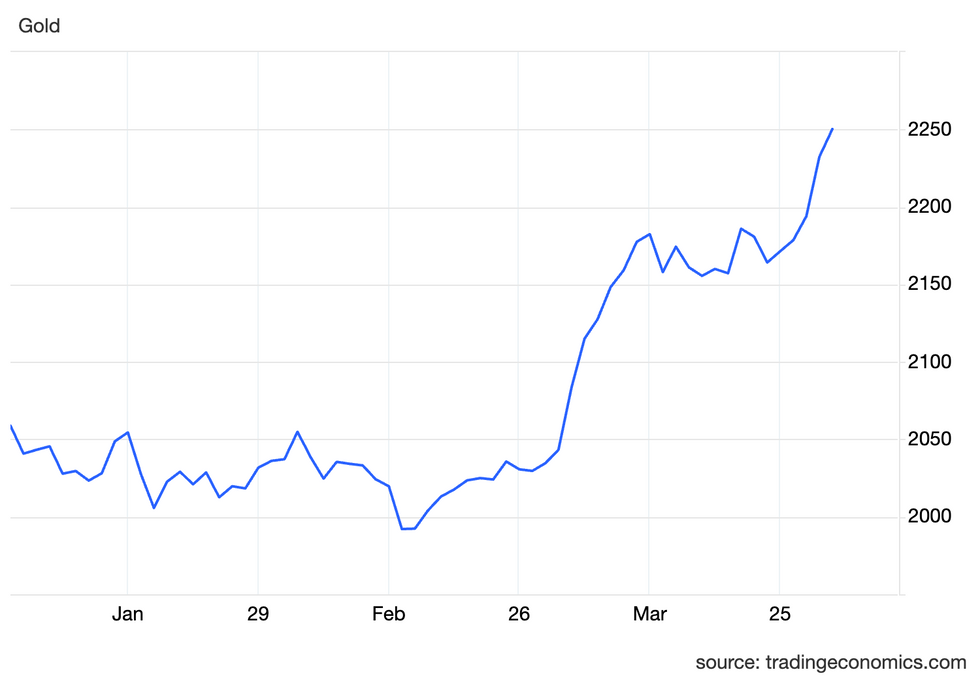
Gold price, Q1 2024.
Chart via Trading Economics.
“As central banks continue to be significant buyers and geopolitical risks and global uncertainties drive investors towards the perceived safety of gold, the current environment underscores gold’s importance as a strategic asset for portfolio diversification and risk mitigation. Therefore, while there may have been a perception of western disinterest in gold, recent developments indicate a sustained and broad-based demand for the precious metal,” Joe Cavatoni, market strategist, Americas, told the Investing News Network (INN) in an email at the time.
Gold price in Q2
The gold price saw increasing momentum in Q2, setting a new all-time of US$2,450.05 on May 20.
Gains through the quarter were influenced by strong central bank demand. Investor sentiment toward the yellow metal also shifted, with outflows from western exchange-traded funds starting to slow.
Although European funds still saw significant declines, it wasn’t all bad news — the US-based SPDR Gold Shares (NYSE:GLD), the Sprott Physical Gold Trust (NYSE:PHYS), Ireland’s Royal Mint Responsibly Sourced Physical Gold ETC (LSE:RMAU) and Switzerland’s UBS ETF Gold (SWX:AUUSI) all saw increases.
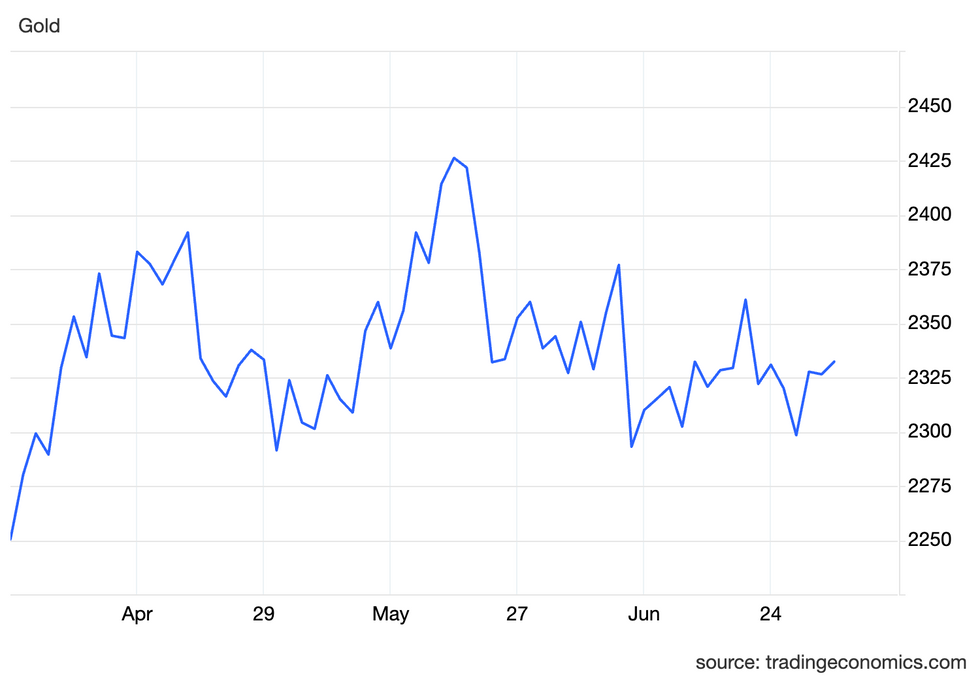
Gold price, Q2 2024.
Chart via Trading Economics.
In a May interview with INN, Jeff Clark, editor of Paydirt Prospector, noted several other market dynamics that caused the price of gold to rise dramatically. He said the real starting point for the precious metal's gains was the end of February, when the Fed indicated it was expecting three or four rate cuts in 2024.
“All of a sudden, gold was off to the races. It jumped so high that suddenly, you had some short covering that needed to happen then as well. So you had short covering, which means they’re buying. And then you had momentum chasers and traders jumping all in. That was a pretty good spike ... that's what kind of started all of this,” he said.
Gold price in Q3
Gold set another record price during the third quarter, reaching US$2,672.51 on September 26.
The high came just a week after the conclusion of the Fed's September meeting, when it announced a jumbo 50 basis point cut to the federal funds rate. While the People’s Bank of China maintained its pause on gold purchases in the third quarter, it granted several regional banks new import quotas in August.
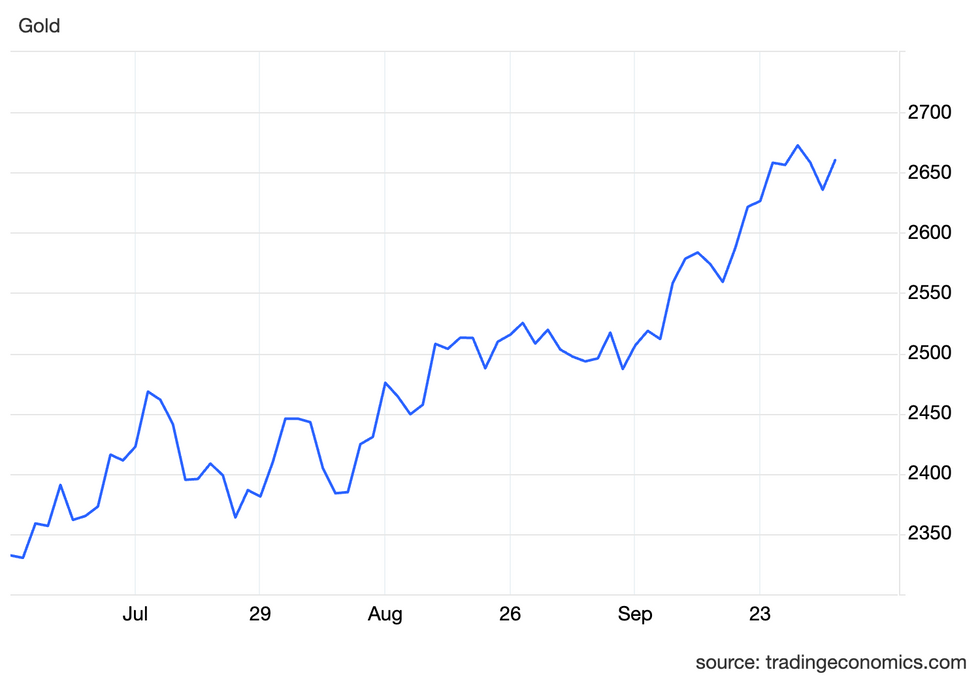
Gold price, Q3 2024.
Chart via Trading Economics.
David Barrett, CEO of the UK division of global brokerage firm EBC Financial Group, suggested at the time that Fed rate cuts were less of a factor for gold than central bank buying. “I still see the global central bank buying as the main driver — as it has been over the last 15 years. This demand removes supply from the market. They are the ultimate buy-and-hold participants and have been buying massive amounts,” he told INN via email.
The quarter also saw significant merger and acquisition activity, with South Africa-based Gold Fields (NYSE:GFI,JSE:GFI) announcing plans to acquire Canada’s Osisko Mining (TSX:OSK) for C$2.16 billion, and South African gold miner AngloGold Ashanti (NYSE:AU) agreeing to purchase UK-based Centamin (TSX:CEE,LSE:CEY) for US$2.5 billion.
Investor takeaway
Overall, uncertainty has been a key driver for gold in 2024.
Central banks have continued to increase their physical holdings against an increasingly polarized political landscape. The most recent data from the World Gold Council shows that they added 186 metric tons of gold to their coffers during the third quarter, with the National Bank of Poland leading the way with 42 metric tons.
The World Gold Council notes that on a rolling four-quarter basis, central bank buying has slowed to 909 metric tons — that's compared to 1,215 metric tons one year ago.
Investors also began returning to the precious metal throughout 2024 as geopolitical tensions and fragile economies pushed them toward gold as a safe haven to help shield their portfolios from volatility.
With the world’s largest economy set to welcome Trump back to the White House in 2025, there are many unknowns. His economic policies could cause inflation to begin creeping up. In contrast, his foreign policies could create new ripples through global trade and financial markets given that he campaigned on more protectionist policies.
Don't forget to follow us @INN_Resource for real-time updates!
Securities Disclosure: I, Dean Belder, hold no direct investment interest in any company mentioned in this article.
Editorial Disclosure: The Investing News Network does not guarantee the accuracy or thoroughness of the information reported in the interviews it conducts. The opinions expressed in these interviews do not reflect the opinions of the Investing News Network and do not constitute investment advice. All readers are encouraged to perform their own due diligence.
First Ore To Be Processed - Boorara Gold Project
Astral Resources Eyes Gold Production at Mandilla Project in Western Australia
Australia-based gold explorer and developer Astral Resources (ASX:AAR) is riding the strong gold price wave as it ramps up exploration and moves toward a prefeasibility study — and ultimately production — at its flagship Mandilla project.
Managing Director Marc Ducler outlined the positive economics for Mandilla, which is in Western Australia. He said they have improved significantly since a scoping study for the project was released in September 2023.
“We were (projecting) a net present value of AU$440 million. And that's at AU$2,750 (for the gold price). You move it to the gold price today, and we have a project that has AU$1.2 billion in net present value and is capable of providing over AU$285 million worth of free cashflow every single year,” he explained.
The company is now progressing from the scoping study to a prefeasibility study and then toward a definitive feasibility study, with intention to develop the Mandilla project through to production.
“You can't have a strategy that's reliant on someone else. And so our strategy is to run through to production. Again, the peak negative cashflow at scoping was AU$191 million. When you have a market cap of AU$150 million, I don't see a significant hurdle to being able to fund that project ourselves. So we certainly aren't in the business of looking for a partner and giving that value away,” Duclar said.
Early in the new year, he said the company will continue its drilling program at the Theia, Iris and Eos targets at Mandilla, and at the Kamperman prospect at the Feysville project, with the goal of updating the resource estimates for both projects.
Astral Resources expects to deliver a prefeasibility study in the second quarter of 2025.
Watch the full interview with Marc Ducler, managing director of Astral Resources, above.
Disclaimer: This interview is sponsored by Astral Resources (ASX:AAR). This interview provides information which was sourced by the Investing News Network (INN) and approved by Astral Resources in order to help investors learn more about the company. Astral Resources is a client of INN. The company’s campaign fees pay for INN to create and update this interview.
INN does not provide investment advice and the information on this profile should not be considered a recommendation to buy or sell any security. INN does not endorse or recommend the business, products, services or securities of any company profiled.
The information contained here is for information purposes only and is not to be construed as an offer or solicitation for the sale or purchase of securities. Readers should conduct their own research for all information publicly available concerning the company. Prior to making any investment decision, it is recommended that readers consult directly with Astral Resourcesand seek advice from a qualified investment advisor.
This interview may contain forward-looking statements including but not limited to comments regarding the timing and content of upcoming work programs, receipt of property titles, etc. Forward-looking statements address future events and conditions and therefore involve inherent risks and uncertainties. Actual results may differ materially from those currently anticipated in such statements. The issuer relies upon litigation protection for forward-looking statements. Investing in companies comes with uncertainties as market values can fluctuate.
Latest News
Latest Press Releases
Related News
TOP STOCKS
Investing News Network websites or approved third-party tools use cookies. Please refer to the cookie policy for collected data, privacy and GDPR compliance. By continuing to browse the site, you agree to our use of cookies.






